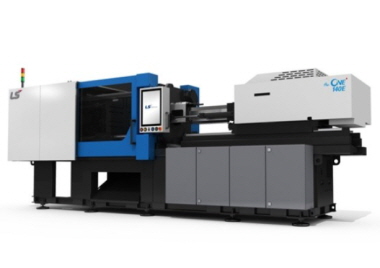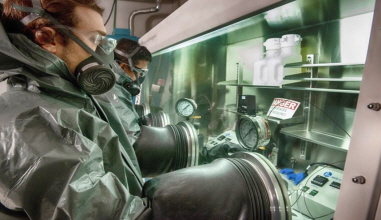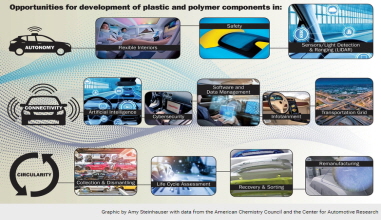Technology & solutions
Romeo RIM transforms mature technology into innovative process
By: Clare Goldsberry in Injection Molding
Romeo RIM, a processor based in Romeo, MI, that specializes in reaction injection molding (RIM), has built its business on innovative cutting edge technology since its founding in 1982. Today, Romeo RIM is putting a modern spin on what used to be thought of as a mature technology—a closed-mold method—into an innovative process that reduces cycle time and costs. That’s how Matt Getty, Vice President of Business and Product Development, explained the company’s initiative to PlasticsToday.
Developed in collaboration with KraussMaffei, the rotary carrier press will reduce cycle times from about 10 to 12 minutes to 60 to 120 seconds.
![]()
▲ Developed in collaboration with KraussMaffei, the rotary carrier press will reduce cycle times from about 10 to 12 minutes to 60 to 120 seconds.
Romeo RIM specializes in RIM, structural RIM (S-RIM), and long-fiber injection (LFI), which is another version of the RIM process. RIM uses two liquid components that are injected into a closed mold. The chemical reaction between the two liquid materials produces a solid plastic part. Typically the material is polyurethane (PU) or dicyclopentadiene (DCPD).
Getty adds that Romeo RIM is “modernizing RIM and making it very competitive in the industry in ways in which people are not aware.” The company can produce parts ranging in size from 3 x 3 to 11.5 x 11.5 feet in a single piece, such as tractor roofs. “All of our processes—both open and closed mold—are low pressure, requiring less force to mold, meaning you can utilize lower-cost materials such as aluminum and nickel shell for tooling, as well as epoxy for lower volume production and prototypes.”
RIM processing can produce parts with a variety of benefits including class-A surfaces, wall thickness changes, impact resistance, encapsulated inserts and in-mold coating. DCPD provides exceptional impact resistance and a good class-A appearance; it is ideal for molding very large parts, Getty explained. As an example, Getty cited an 8-x-5-foot component the company molds as one piece—consolidating the part in one molding cycle—that previously had been molded in several pieces. “DCPD is excellent for heavy truck, agriculture and construction applications,” he added.
In the LFI process, PU is mixed with chopped fiberglass. “We have the ability to engineer a composite part with different mechanical performance levels to meet customer requirements,” explained Getty. He adds that LFI is 70% lighter than steel, 20% lighter than aluminum and 40% lighter than sheet molding compound, and it is 50% lighter than fiberglass-reinforced plastic in density.
For the LFI process, Romeo RIM uses robots to spray the slurry into the open mold; the PU resin is simultaneously poured with the chopped fiberglass in varying lengths, typically 1 inch. The process involves low-compression molding to form parts, such as roofs for tractors and other heavy equipment, and body panels. The benefits of this process are low tooling costs and dimensional stability, as well as optimized weight and strength. In addition, the ability to in-mold paint (IMP) is a game changer.
S-RIM is a composite molding process that also uses a PU resin. This allows Romeo RIM to achieve higher mechanical properties with aligned fibers in the process.
Getty said that companies in the markets they serve are mostly interested in the LFI technology. “A lot of that is because it’s taking the same lightweight aspects—same weight as DCPD resin—and introducing rovings into it, leading to a much stiffer component than the DCPD. The rovings are positioned randomly in LFI, but provide a uniform property throughout the product. We mix PU resin and chop the fiberglass within the mix head, then spray that mixture into the mold and mold the part. It’s very cost competitive that way,” he explained.
One of the company’s specialties is IMP, which was commercialized in the 1980s. The process involves painting the cavity of the tool immediately prior to injecting the PU with or without chopped glass. During the molding process, the paint chemically bonds to the PU material, becoming an integral part of the substrate. “This provides superior paint adhesion compared with traditional post-mold painting processes,” said Getty. “It’s also more cost effective than post-mold painting as a secondary operation because there’s no cleaning, prepping, sanding or priming. And we get a Class-A surface finish right out of the mold.
“We are seeing demand for products using these processes in trucks and heavy equipment for the agricultural and construction industries,” said Getty. “They use the LFI process for different benefits such as the lightweight aspect, as well as the paint finish quality, particularly in construction equipment that gets a lot of abuse. The cost savings of molding components like hoods in one piece is also a big factor.”
The next big thing for Romeo RIM, in collaboration with machine supplier KraussMaffei, is a 100% robotically controlled 9-x-4.5-foot rotary carrier press that will reduce cycle times from about 10 to 12 minutes to 60 to 120 seconds with in-mold painting robotically applied. “We’re going through de-bugging now and plan to start production in the next couple of weeks on what we believe is the fastest LFI molding machine in North America and maybe the world,” Getty stated. “It’s one of the most innovative things KraussMaffei has done; together we really pushed the limits of this technology.”
The rotary operation of the new press has seven different mold carriers on a track and three different primary cells. In one cell, the robot sprays the paint; the second cell sprays another PU layer; and a third cell applies the LFI material. “This machine is fast, efficient and can mold seven different parts in six different colors with redundant systems so that all is done at the same time without having to shut the press down. It’s definitely more competitive from a price standpoint.”
https://www.plasticstoday.com/injection-molding/romeo-rim-transforms-mature-technology-innovative-process/203234334056592?cid=flyout




















